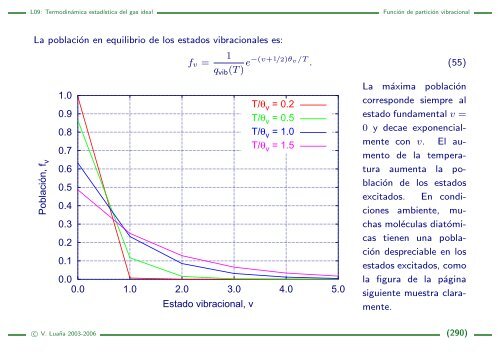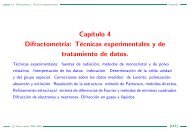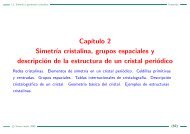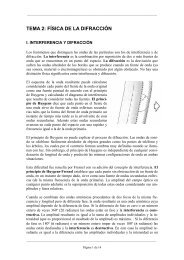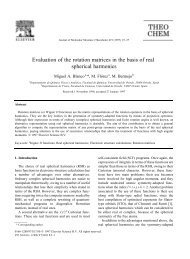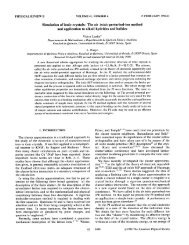L09: Termodinámica estadística del gas ideal
L09: Termodinámica estadística del gas ideal
L09: Termodinámica estadística del gas ideal
You also want an ePaper? Increase the reach of your titles
YUMPU automatically turns print PDFs into web optimized ePapers that Google loves.
<strong>L09</strong>: <strong>Termodinámica</strong> <strong>estadística</strong> <strong>del</strong> <strong>gas</strong> <strong>ideal</strong> Función de partición vibracional<br />
La población en equilibrio de los estados vibracionales es:<br />
Población, f v<br />
1.0<br />
0.9<br />
0.8<br />
0.7<br />
0.6<br />
0.5<br />
0.4<br />
0.3<br />
0.2<br />
0.1<br />
fv =<br />
1<br />
qvib(T ) e−(v+1/2)θv/T . (55)<br />
0.0<br />
0.0 1.0 2.0 3.0 4.0 5.0<br />
Estado vibracional, v<br />
T/θ v = 0.2<br />
T/θ v = 0.5<br />
T/θ v = 1.0<br />
T/θ v = 1.5<br />
La máxima población<br />
corresponde siempre al<br />
estado fundamental v =<br />
0 y decae exponencialmente<br />
con v. El aumento<br />
de la temperatura<br />
aumenta la población<br />
de los estados<br />
excitados. En condiciones<br />
ambiente, muchas<br />
moléculas diatómicas<br />
tienen una población<br />
despreciable en los<br />
estados excitados, como<br />
la figura de la página<br />
siguiente muestra claramente.<br />
c○ V. Luaña 2003-2006 (290)


